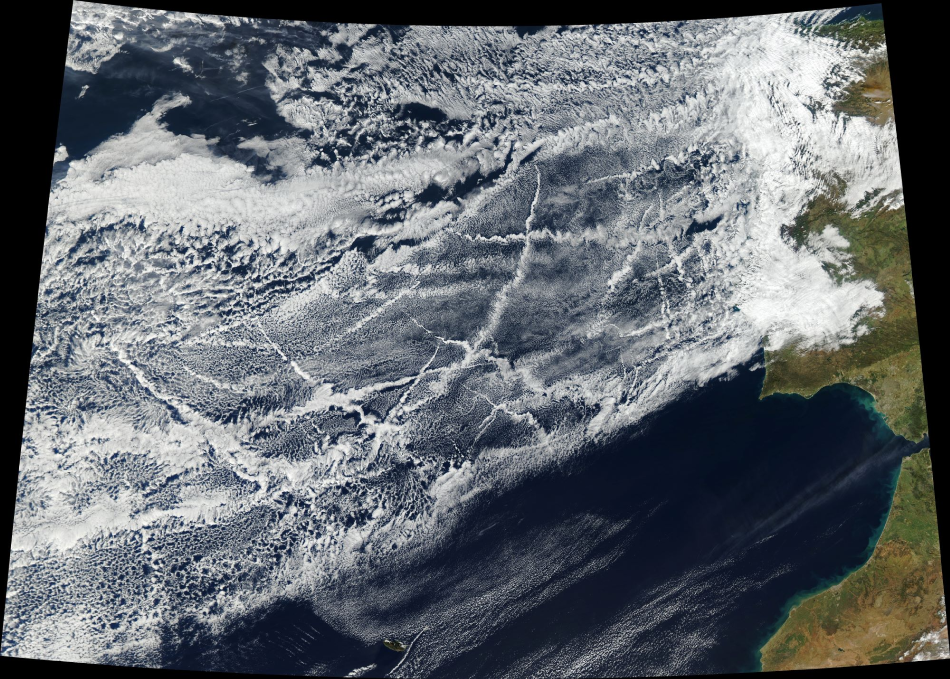Mar 25 2020
A trail of white clouds left by a container ship can remain in the air for hours. This puffy trail is not just the engine’s exhaust, but a change in the clouds caused by tiny floating particles of pollution.
 This satellite image was taken on January 16th, 2018, off the coast of Europe. Pollution from ships creates lines of clouds that can stretch hundreds of miles. The narrower ends of the clouds are youngest, while the broader, wavier ends are older. Image Credit: NASA Earth Observatory.
This satellite image was taken on January 16th, 2018, off the coast of Europe. Pollution from ships creates lines of clouds that can stretch hundreds of miles. The narrower ends of the clouds are youngest, while the broader, wavier ends are older. Image Credit: NASA Earth Observatory.
A new study headed by the University of Washington is the first to quantify the effect of this phenomenon across years and at a regional scale. Satellite data collected from a shipping lane in the south Atlantic revealed that the ships alter clouds to block an additional 2 W of solar energy, on average, from reaching each square meter of the surface of the ocean close to the shipping lane.
The result suggests that on a global level, cloud changes induced by particles from all kinds of industrial pollution block 1 W of solar energy for each square meter of the surface of Earth, masking nearly a third of today’s warming caused by greenhouse gases. The open-access study was published in AGU Advances, a journal of the American Geophysical Union, on March 24th, 2020.
In climate models, if you simulate the world with sulfur emissions from shipping, and you simulate the world without these emissions, there is a sizable cooling effect from changes in the model clouds due to shipping. But because there’s so much natural variability it’s been hard to see this effect in observations of the real world.
Michael Diamond, Study First Author and Doctoral Student, Department of Atmospheric Sciences, University of Washington
The new research utilizes observations made between 2003 and 2015 in spring—the cloudiest season—over the shipping route between South Africa and Europe. This route is also a part of a common open-ocean shipping route between Asia and Europe.
Tiny particles in exhaust, released by burning fossil fuels, create “seeds” on which atmospheric water vapor can condense into cloud droplets. Additional particles of airborne sulfate or other material result in clouds with further small droplets, as opposed to the same quantity of water condensed into fewer, larger droplets. This causes the clouds to appear brighter, or more reflective.
Earlier attempts to quantify this effect from ships had looked only at places where the wind blows through the shipping lane, to make a comparison between the “clean” area upwind and the “polluted” area downstream.
However, in this study, the team targeted an area that had not been included before: a place where the wind blows throughout the shipping lane, keeping pollution levels concentrated in that small area.
The research examined cloud properties that were detected more than 12 years by the MODIS instrument on NASA satellites and the quantity of reflected sunlight at the top of the atmosphere from the CERES group of satellite instruments. Cloud properties within the shipping route were compared with an approximation of what those cloud properties would have been in the absence of shipping based on statistics from adjacent, unpolluted areas.
The difference inside the shipping lane is small enough that we need about six years of data to confirm that it is real. However, if this small change occurred worldwide, it would be enough to affect global temperatures.
Hannah Director, Study Co-Author and Doctoral Student, Department of Statistics, University of Washington
Once the researchers quantified the effect of ship emissions on solar radiation, they used that number to predict how much cloud brightening from all industrial pollution has impacted the climate in general.
Averaged worldwide, the researchers discovered that changes in low clouds caused by pollution from all sources block 1 W/m2 of solar energy—in comparison to about 3 W/m2 trapped presently by the greenhouse gases also produced by industrial activities.
This means, without the cooling effect of pollution-seeded clouds, Earth could have already been warmed by 1.5 °C (2.7 °F)—a variation that would have substantial societal influences according to the Intergovernmental Panel on Climate Change projects. (For comparison, presently, the Earth is estimated to have warmed by about 1 °C, or 1.8 °F, after the late 1800s.)
I think the biggest contribution of this study is our ability to generalize, to calculate a global assessment of the overall impact of sulfate pollution on low clouds.
Rob Wood, Study Co-Author and Professor, Department of Atmospheric Sciences, University of Washington
These outcomes also hold implications for one probable mechanism of intentional climate intervention. According to the team, strategies to provisionally slow down global warming by spraying salt particles to render low-level marine clouds more reflective, referred to as marine cloud brightening, might be fruitful. But they also indicate that these variations could take years to be easily noticed.
“What this study doesn’t tell us at all is: Is marine cloud brightening a good idea? Should we do it? There’s a lot more research that needs to go into that, including from the social sciences and humanities,” Diamond added. “It does tell us that these effects are possible—and on a more cautionary note, that these effects might be difficult to confidently detect.”
Other co-authors of the study are Ryan Eastman, a UW research scientist in atmospheric sciences, and Anna Possner at Goethe University in Frankfurt. The study received funding from NASA and the National Science Foundation.